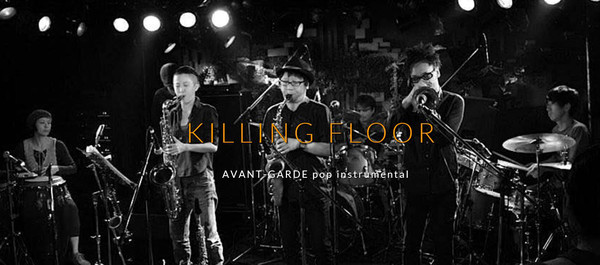
Killing Floor
Ratty Jass
Album JP 2003 on Captain Trip Records label
Jazz (Avant-garde Jazz, Fusion, Jazz-Rock, Free Improvisation)
Killing Floor’s “Ratty Jass,” is loud, electric, hard-edged and energetic. Working in a fusion-ish mode, their description of the CD as “Avant-garde Pop Jazz” is apt. The avant-garde element comes from broken rhythms, strange textures and moments of cleverly “out” playing. The pop element comes from the electric instrumentation and a rollicking beat. The jazz element, perhaps better written as “jass,” one of the original spellings of the word at the turn of the century, is evident in their odd configurations, strange phrasings and generally unconventional approach. The band paints on a broad canvas. The core is three horns, three percussionists and a “stick” bass. With plenty of guests added to the mix, they push the edges of their songs far and wide. The expanse of sonic space allows them to reveal a great deal of honest, even earnest, energy from all the players. They are having a raucous good time blasting open the melodies, drumming for all they are worth, and creating fresh, odd, concoctions of elements. Their experiments don’t always work, bits and pieces of songs sound repetitive or too easily resolved, but the collective enthusiasm carries the band past those rough points. Moving between thick bass lines and minor melody lines taken by the horn section, the rhythms never slacken. They have worked carefully to pin down each part of their mix, but leave everything just a little rough and relaxed. The layers of sound go in all different directions for a strangely woven texture. That strangeness, though, feels just right—strange with a laugh. “Golden Elephant” dips into an Indian harmony that could come from a Bombay film soundtrack and work on a disco floor, but contains an ironic interplay of musical ideas. It’s ethnic, but not purely so. “Sambacar Nival” has a similar ethnic blend, this time of carnival rhythms. Still, the group marches to the sound of their own drummer--or rather three different drummers. With three horns, three percussionists and a “stick” in the middle, Killing Floor keeps its instrumentation unusual as well. Jazz purists (never noted for their sense of humor) will probably find much to criticize with this release. Repeated listenings, though reveal Killing Floor’s good-time feel and high level of musicianship hidden in the quirky style, however. For example, “Waltz for K” has a delightfully odd meter, as does “Take 7.” These two tunes are complex, even when they appear to be simply a let-loose blowing section. Their free-form, high-energy flow owes something to the jam band movement, with a punk-ish sensibility, but the tight horn section, intense drumming and expansive soloing mark this as a solid jazz release. Those music lovers who enjoy hearing unexpected bits and pieces and enjoy their energy a little more raw and unhidden will find this release to be a real pleasure. Jazz in Japan
Musicians
 | Killing Floor , album by |
 | Mikio Fukushima ss, as, alto saxophone, soprano saxophone |
 | Katsuaki Takagai ts, bs, baritone saxophone, tenor saxophone |
 | Katsuyuki Nishiyama b, bass, stick |
 | Atsushi Nakazato perc, dr, drums, percussion |
 | Daichi Itoh perc, dr, drums, percussion |
 | Tomomi Takenoya perc, dr, drums, percussion |
 | Hasiken bj, guest, banjo, sanshin |
 | Katsuhiro Okino eg, guest, electric guitar |
 | Yuki SAMBACAR Team perc, guest, percussion |
 | Ren Takida sit, guest, sitar, electric sitar |
 | Kei Mizorogi tb, guest, trombone |
 | Mayumi Yoshimura tb, guest, trombone |
 | Rumie Tada tb, guest, trombone |
 | Toshihiro Koike tb, guest, trombone |
 | Shinichiro Sekiguchi tr, trumpet |
Album Tracks
| No | Title | Artist | Composer | Duration |
|---|---|---|---|---|
| 1 | Mana Bee | Killing Floor | 1:40 | |
| 2 | S.Ska | Killing Floor | 4:52 | |
| 3 | Waltz For K | Killing Floor | 11:04 | |
| 4 | Sea Monkey | Killing Floor | 4:46 | |
| 5 | Take 7 | Killing Floor | 3:27 | |
| 6 | Golden Elephant | Killing Floor | 4:59 | |
| 7 | Sambacarnival | Killing Floor | 8:17 | |
| 8 | Papappa-Rappa | Killing Floor | 2:04 |
